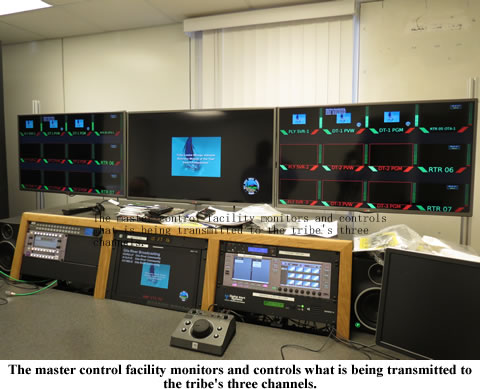 |
Canku Ota
|
 |
|
(Many Paths)
|
||
|
An Online Newsletter
Celebrating Native America
|
||
|
February 2015 - Volume
13 Number 2
|
||
|
|
||
|
Gila River Indian
Community To Launch A Low-Power Television Station
|
||
|
by Carrie Jung - KJZZ
|
||
|
credits: All photos by
Carrie Jung - KJZZ
|
|
The Gila River Indian Community joins a growing number of tribes launching their own media outlets. Until recently, if you flipped to TV channels 19, 21, or 29 on the Gila River reservation, all you'd get was a blank screen. Today, that's completely different. Now when viewers tune in, they'll see one of more than a dozen public service announcements currently looping on those channels as part of a signal test. "We're actually receiving an antenna signal over 12 miles away right now," said Derek White, the general manager at Gila River Telecommunications as he made his way to the master control facility for the organization's new TV station.
"We are taking that walk-before-we run kind of approach," said White. "And so instead of building a full blown production studio we've gone and kind of converted an old tech room into a master control center. That allows us to really test and prove out our television capabilities." While White admits the facility is modest he said getting this set up was an important step in getting the TV station off the ground. "We are actually at limited power at two of our stations," said White. "But we are actually receiving some input from our community members that are just happening to find our stations." After spending more than a year getting the necessary paperwork from the Federal Communications Commission, tribal officials decided to begin transmitting the signal test last month to prevent losing their licenses. Gila River Telecommunications board member John Lewis said that limited programming should change soon though, with plans for a local newscast and children's shows coming through the pipeline. "There really isn't anybody to provide that kind of community-based information that's geared toward our culture," he said. "And so this is really the only way we would get something like this." Lewis said when the station is up and running at full power more than 90 percent of people on the reservation with an antenna will be able to pick up the signal. Loris Taylor is the president of Native Public Media, a group working to increase media access and media control in Native American communities. She said the Gila River Indian Community is one of a growing number of tribes launching their own media networks, especially radio stations. "In 2004 we started out with 30 radio stations serving tribal communities. And over the past few years we've grown to 53 stations," Taylor said. "Which is not enough when you have 566 American Indian tribes and Alaska Native villages in the United States." Taylor said there are even fewer tribes running TV stations. The Chickasaw Nation in Oklahoma operates an internet-based TV station and the San Manuel tribe in California broadcasts on a public access channel. But Taylor said as far as she knows, Gila River Indian Community is the first tribe to both own and manage a low-power digital TV station. "Information is really essential to nation building," she said. "You need information to inform your citizens about the economy about their health. It's also important to their public safety and national security." For Lewis, running a TV station is new territory for him that he admits will take some getting used to. "Right now we're getting our feet wet," said Lewis. "Its going to be very interesting to see how we proceed from here and this is all new for us." The tribe plans to announce the official launch of the station, to be known as the Gila River Broadcasting Corporation, in mid-February. |
|
|
||
|
|
||
| Canku Ota is a free Newsletter celebrating Native America, its traditions and accomplishments . We do not provide subscriber or visitor names to anyone. Some articles presented in Canku Ota may contain copyright material. We have received appropriate permissions for republishing any articles. Material appearing here is distributed without profit or monetary gain to those who have expressed an interest. This is in accordance with Title 17 U.S.C. Section 107. | ||
|
Canku Ota is a copyright ©
2000 - 2014 of Vicki Williams Barry and Paul Barry.
|
||
 |
 |
|
|
The "Canku
Ota - A Newsletter Celebrating Native America" web site and
its design is the
|
||
|
Copyright ©
1999 - 2014 of Paul C. Barry.
|
||
|
All Rights Reserved.
|
||
 For
many on the Gila River Indian Community in central Arizona, getting
clear a clear TV signal can sometimes be a challenge. But that's
about to change. In February, the tribe plans to launch its own
low-power television station with repeaters across the reservation.
For
many on the Gila River Indian Community in central Arizona, getting
clear a clear TV signal can sometimes be a challenge. But that's
about to change. In February, the tribe plans to launch its own
low-power television station with repeaters across the reservation. The
control room is pretty plain, about 100 square feet with two electronic
bays housing some editing and monitoring equipment.
The
control room is pretty plain, about 100 square feet with two electronic
bays housing some editing and monitoring equipment.